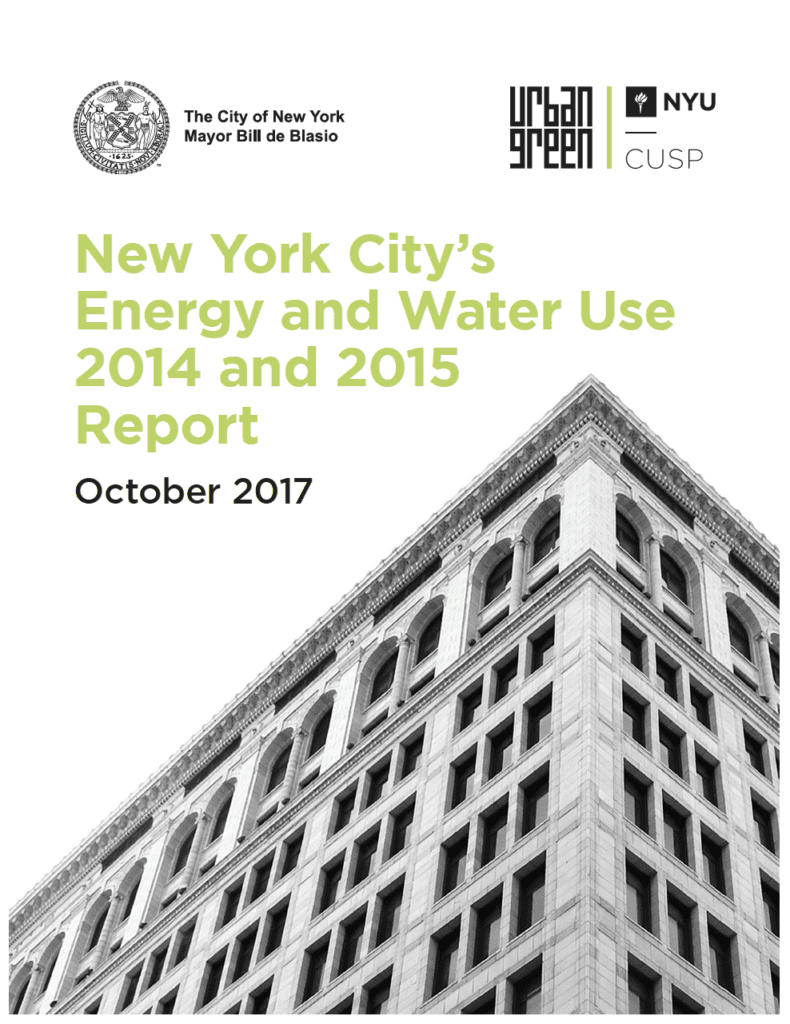We combined the 2014 and 2015 New York City building benchmarking data with building auditing data to explore energy use and systems in thousands of NYC buildings.
Original publication by Urban Green Council • October 16, 2017
The buildings studied in this report make up almost half of NYC’s total floor area—roughly 2.6 billion square feet. The report also includes 450 million square feet of municipal building area.
Collected under Local Laws 84 and 87, this data shows the amount of energy and water used by our buildings, as well as how they’re using it.

In 2014 and 2015…
- Large buildings cut their total emissions by almost 14 percent and energy usage by nearly 10 percent.
- Large buildings accounted for 30 percent of NYC emissions.
- Heavy fuel oil use decreased.
This report contains a series of firsts:
- The first time municipal buildings’ benchmarking data has been looked at in the context of the entire city;
- The first ENERGY STAR score rankings for multifamily buildings;
- The first integration of data from benchmarking with data available in the City’s Greenhouse Gas Inventory—creating a more accurate picture of how New York’s large buildings contribute to citywide carbon emissions.
Emissions down 14 percent
Large NYC buildings continue to cut their energy and carbon emissions. Buildings that regularly benchmarked have decreased their energy usage by nearly 10 percent and their total emissions by almost 14 percent.
This is encouraging news. However, it is important to note that half of these declines are due to a cleaner electrical grid and more efficient district steam generation. Now that most New York State electricity generation from coal and oil has transitioned to natural gas and renewables, building owners will have to dig deeper into energy efficiency to keep up the pace.
Large buildings account for 30 percent of NYC emissions
- Benchmarked buildings occupy 33 percent of the building area in the Greenhouse Gas Inventory.
- Benchmarked buildings accounted for 30 percent of the inventoried building emissions.
- In 2015, benchmarked buildings emitted less carbon per square foot than the mid-sized and small buildings that were not benchmarked.
- Benchmarked commercial buildings—including offices, retail locations and hotels—were responsible for 13 percent of total emissions.
- Benchmarked multifamily buildings accounted for 17 percent of total emissions.
Heavy fuel oil use decreased
The NYC Clean Heat program was a major factor that contributed to the 14 percent emissions reductions reported between 2010 and 2015. The Department of Environmental Protection (DEP) phased out the use of the heaviest oils—fuel oils number 5 and 6—as primary heating fuels between 2011 and 2015. The City has achieved nearly full compliance with this regulation.
The decrease in heavy fuel oil use was confirmed by the benchmarking data. In 2010, more than 1,000 buildings reported using number 6. By 2015, those buildings had reduced their heavy fuel energy use by 92 percent. Buildings switching away from those fuel oils replaced them with natural gas or else fuel oil numbers 2 and 4. And though natural gas use in these buildings nearly tripled over the six years, overall energy use dropped—partly due to efficiencies afforded by new equipment and building improvements.
Efficiency is improving, but reductions have been uneven
Building sectors varied in their energy reductions, but each has seen at least a slight decrease in energy intensity. After an initial 5 percent drop, multifamily buildings have been stagnant for the past few years; offices have experienced regular declines and universities have been the all-stars of NYC, with a 20 percent reduction.
What we’ve learned about building systems
- Almost 90 percent of audited floor area is heated by a boiler that works double duty as a domestic hot water heater, despite frequent auditor recommendations to split those systems. Buildings with these combined systems were observed to consume over 20 percent more fuel than buildings with separate DHW systems.
- Technological efficiency doesn’t always trump responsible behavior by the people occupying buildings. This is especially true when it comes to air conditioning: The City’s current data presents certain paradoxes, as it indicates that buildings with distributed systems used less energy, even though central system equipment is almost always more efficient per unit of cooling produced.
- Few multifamily buildings are master metered, but the benchmarking and audit data indicated that direct-metered multifamily buildings consumed less electricity per square foot than master-metered buildings.
Dive into our analysis of each of these issues and see our complete list of findings and recommendations in the full report.
This report was created in partnership with the NYC Mayor’s Office of Sustainability and NYU Center for Urban Science and Progress.
Related press

Download New York City’s Energy and Water Use 2014 and 2015 Report
Click here to read the full report PDF.